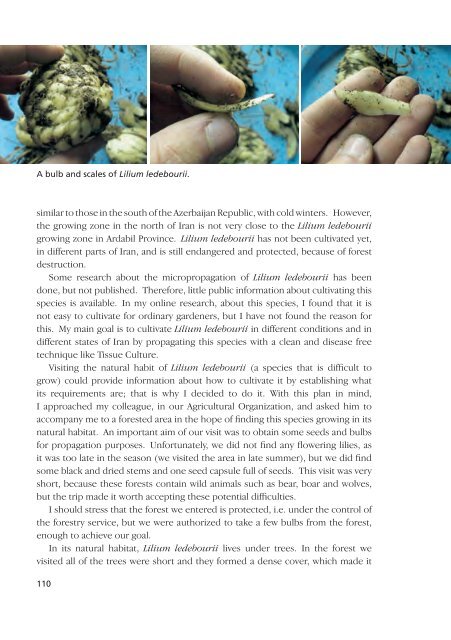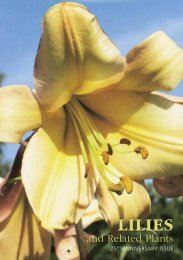Lilies and Related Plants - RHS Lily Group
Lilies and Related Plants - RHS Lily Group
Lilies and Related Plants - RHS Lily Group
You also want an ePaper? Increase the reach of your titles
YUMPU automatically turns print PDFs into web optimized ePapers that Google loves.
A bulb <strong>and</strong> scales of Lilium ledebourii.<br />
similar to those in the south of the Azerbaijan Republic, with cold winters. However,<br />
the growing zone in the north of Iran is not very close to the Lilium ledebourii<br />
growing zone in Ardabil Province. Lilium ledebourii has not been cultivated yet,<br />
in different parts of Iran, <strong>and</strong> is still endangered <strong>and</strong> protected, because of forest<br />
destruction.<br />
Some research about the micropropagation of Lilium ledebourii has been<br />
done, but not published. Therefore, little public information about cultivating this<br />
species is available. In my online research, about this species, I found that it is<br />
not easy to cultivate for ordinary gardeners, but I have not found the reason for<br />
this. My main goal is to cultivate Lilium ledebourii in different conditions <strong>and</strong> in<br />
different states of Iran by propagating this species with a clean <strong>and</strong> disease free<br />
technique like Tissue Culture.<br />
Visiting the natural habit of Lilium ledebourii (a species that is difficult to<br />
grow) could provide information about how to cultivate it by establishing what<br />
its requirements are; that is why I decided to do it. With this plan in mind,<br />
I approached my colleague, in our Agricultural Organization, <strong>and</strong> asked him to<br />
accompany me to a forested area in the hope of finding this species growing in its<br />
natural habitat. An important aim of our visit was to obtain some seeds <strong>and</strong> bulbs<br />
for propagation purposes. Unfortunately, we did not find any flowering lilies, as<br />
it was too late in the season (we visited the area in late summer), but we did find<br />
some black <strong>and</strong> dried stems <strong>and</strong> one seed capsule full of seeds. This visit was very<br />
short, because these forests contain wild animals such as bear, boar <strong>and</strong> wolves,<br />
but the trip made it worth accepting these potential difficulties.<br />
I should stress that the forest we entered is protected, i.e. under the control of<br />
the forestry service, but we were authorized to take a few bulbs from the forest,<br />
enough to achieve our goal.<br />
In its natural habitat, Lilium ledebourii lives under trees. In the forest we<br />
visited all of the trees were short <strong>and</strong> they formed a dense cover, which made it<br />
110




